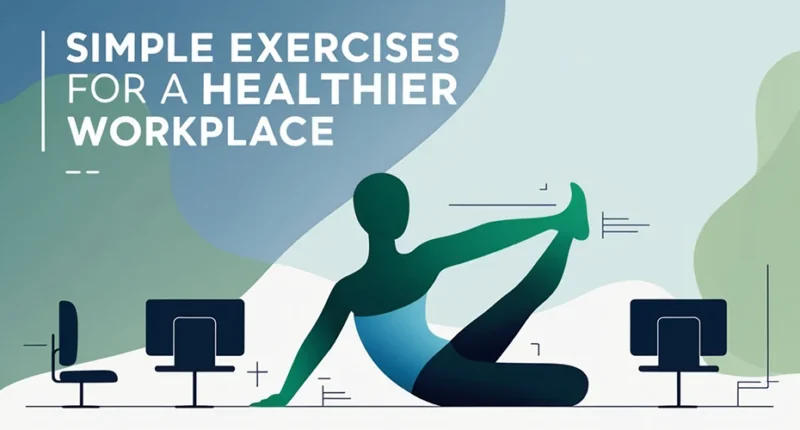Table of Contents
Working in an office or any workplace where you’re sitting for long hours can take a toll on your body. From back pain to stiff muscles, the lack of movement can cause discomfort and even lead to more serious health issues over time. But don’t worry! You don’t need a gym to stay active during your workday. Simple exercises can help you stay healthy, improve your posture, and reduce stress.
1. Desk Stretches
Sitting at your desk all day can make your muscles tight, especially in your back, neck, and shoulders. Taking a few minutes every hour to stretch can make a big difference. Here’s how you can do a basic desk stretch:
- Sit up straight with your feet flat on the floor.
- Reach your arms overhead and gently stretch to the right and left to stretch out your sides.
- Place your right hand behind your head and gently pull your elbow down to stretch your triceps.
- Stretch your neck by tilting your head from side to side slowly, holding each stretch for 10-15 seconds.
These simple stretches will help keep your muscles from getting too stiff and improve your flexibility.
2. Seated Leg Extensions
Seated leg extensions are a great way to strengthen your legs and improve circulation, especially if you spend most of your day sitting. Here’s how you do them:
- Sit at the edge of your chair with your back straight.
- Extend your right leg straight out in front of you, keeping your foot flexed.
- Hold for 3-5 seconds, then slowly lower your leg back down.
- Repeat 10-15 times on each leg.
This exercise helps with leg strength and circulation, and it can also help relieve the tension that builds up in your lower body after hours of sitting.
3. Standing Calf Raises
Standing calf raises are easy to do and can be done while you’re waiting for your coffee to brew or while on a break. They help improve your leg strength and get your blood flowing:
- Stand up straight with your feet shoulder-width apart.
- Slowly raise your heels off the floor so you’re standing on your toes.
- Hold for 2-3 seconds, then lower your heels back down.
- Repeat 10-15 times.
This exercise is great for strengthening your calves and improving balance. Plus, it’s an easy way to get moving without needing extra space or equipment.
4. Shoulder Rolls
Shoulder tension is a common complaint in office workers, but shoulder rolls can help relieve that tightness. Here’s how to do them:
- Sit or stand up straight, with your arms relaxed by your sides.
- Slowly roll your shoulders forward in a circular motion 10 times, then roll them backward 10 times.
- Try to make the circles as big as you can to stretch the shoulder muscles.
This simple exercise will help reduce tightness in the shoulders and upper back, areas that tend to stiffen from long periods of sitting.
5. Desk Push-ups
Push-ups are a great full-body exercise, but they can be challenging when you’re at work. Instead of doing traditional push-ups on the floor, you can do desk push-ups, which are easier on your body:
- Stand a few feet away from your desk, place your hands on the edge, and step your feet back.
- Lower your chest toward the desk by bending your elbows.
- Push back up to the starting position.
- Repeat 10-15 times.
This exercise helps strengthen your arms, chest, and core while also improving your posture.
6. Neck and Upper Back Release
A stiff neck and upper back are common issues for people who spend hours working at a desk. Here’s a simple way to release tension:
- Sit up straight and gently tilt your head forward, bringing your chin toward your chest.
- Slowly roll your head from side to side, holding each side for 5-10 seconds.
- Sit tall and interlace your fingers behind your head, gently pulling forward to stretch your upper back.
This exercise helps release the tightness in the neck and upper back, making you feel more relaxed and less stiff after long hours of sitting.
7. Walking Breaks
One of the simplest and most effective ways to stay healthy at work is to take walking breaks. You don’t have to walk around for an hour—just taking a few minutes every hour to walk around can make a difference:
- Take a brisk walk around your office or step outside for a quick 5-10 minute stroll.
- If possible, take the stairs instead of the elevator.
This will not only help you stay physically active, but it can also improve focus and productivity throughout the day.
8. Wrist and Finger Stretches
If you type a lot or use a mouse all day, your wrists and fingers can become tense. To relieve this, try this quick stretch:
- Extend your arm in front of you, palm facing out.
- Use your opposite hand to gently pull back on your fingers, stretching your wrist and forearm.
- Hold for 10-15 seconds, then switch hands.
This will help release any tension in the wrists and fingers and prevent pain or discomfort from repetitive movements.
Conclusion
Incorporating simple exercises into your daily routine can improve your overall health and well-being at work. These exercises are easy to do, don’t require special equipment, and can help reduce the risks of sitting for long periods. Taking short breaks throughout the day to stretch, strengthen your muscles, and improve circulation can make a huge difference in how you feel both at work and outside of work. So, get moving, and start feeling better today!











